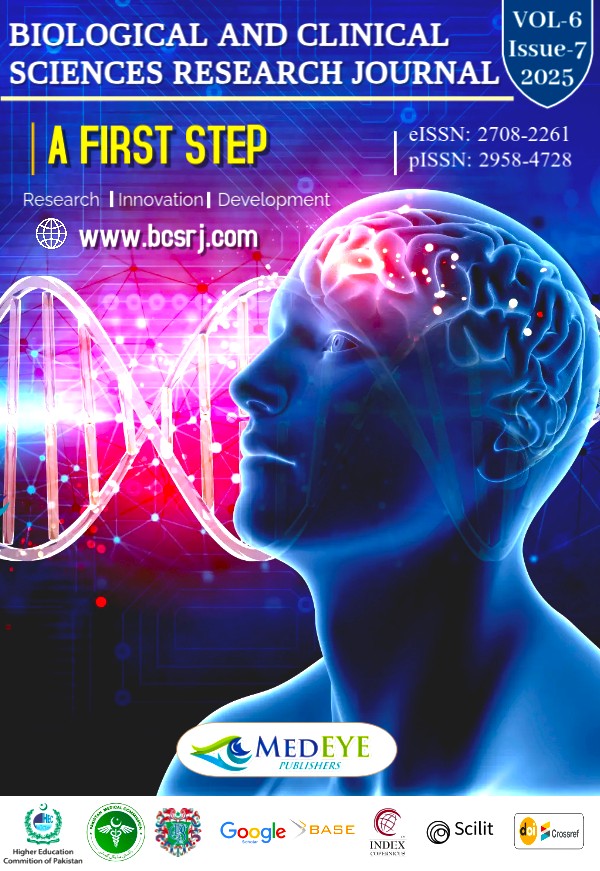Impact of Tramadol Administration on Cardio-Electrophysiological Balance following General Surgery
DOI:
https://doi.org/10.54112/bcsrj.v6i7.1903Keywords:
Arrhythmias, Cardiac; Electrocardiography; Electrophysiology; Postoperative Period; Surgical Procedures, Operative; Tramadol.Abstract
Tramadol is widely used for perioperative analgesia but has been implicated in electrophysiological effects on ventricular repolarisation and conduction. The index of cardiac electrophysiological balance (ICEB = QT/QRS) and its corrected form (ICEBc = QTc/QRS) are emerging ECG-derived markers linked to pro-arrhythmic risk. Evidence on tramadol's impact on these indices in surgical patients is limited. Objective: To assess the effect of intravenous tramadol on ICEB and ICEBc in adults undergoing general surgery. Methods: This prospective, single-centre, pre–post observational study was conducted in the General Surgery Department of Ibn-e-Siena Hospital, Multan, from June 2024 to June 2025. We enrolled 100 consecutive adults undergoing general surgery. All patients received intravenous tramadol 2 mg/kg. Standardized 12-lead ECGs were obtained immediately before and after tramadol administration to measure QT, QTc, and QRS; ICEB was calculated as QT/QRS and ICEBc as QTc/QRS. Vital signs (blood pressure, heart rate, oxygen saturation) were monitored throughout. Percentage change from baseline was computed for each parameter. Descriptive statistics summarized data; pre–post differences were tested using two-sided paired tests with α=0.05. Linear regression explored the association between tramadol dose (total mg, reflecting weight-based dosing) and post-dose ICEBc, adjusting for the corresponding baseline value. Results: Heart rate changed by 0.5% from baseline. QT and QTc increased by 2.5% (both p<0.001). QRS duration decreased by 4.5% after tramadol. ICEB and ICEBc increased by 3.6% and 3.3%, respectively. In regression analysis, tramadol dose independently predicted higher corrected ICEB (β=0.198, p=0.005). No deaths or serious arrhythmias were observed during follow-up. Conclusion: Intravenous tramadol is associated with statistically significant, directionally pro-arrhythmic shifts in ECG-derived indices of electrophysiological balance (increased ICEB/ICEBc) in general-surgery patients, although no serious arrhythmias occurred. Peri-operative monitoring of repolarization and conduction parameters may be prudent when tramadol is used, particularly at higher weight-based doses.
Downloads
References
Coccolini F, Corradi F, Sartelli M, Coimbra R, Kryvoruchko IA, Leppaniemi A, et al. Postoperative pain management in non-traumatic emergency general surgery: WSES-GAIS-SIAARTI-AAST guidelines. World J Emerg Surg. 2022;17(1):50. https://doi.org/10.1186/s13017-022-00455-7
Kaya A, Usta B. Comparison the efficacy of intravenous and topical tramadol on postoperative pain control after septoplasty. Int J Curr Med Biol Sci. 2023;3(2):104-110. https://doi.org/10.5281/zenodo.8072162
Asadi P, Kasmaei VM, Ziabari SMZ, Pourshafiei SH, Roodsari NN, Sigaroudi FE, et al. Predicting factors for electrocardiographic findings in patients with tramadol-induced seizure. J Opioid Manag. 2022;18(3):165-171. https://doi.org/10.5055/jom.0863
Omraninava A, Mehdizade A, Karimi E, Ghabousian A. Potential impact of 3% hypertonic saline infusion on tramadol poisoning-induced electrocardiogram changes: a randomized clinical trial. Arch Acad Emerg Med. 2022;10(1):e26. https://doi.org/10.22037/aaem.v10i1.1511
Guzelcicek A, Kilinc E, Fedai H, Dedeoglu NF, Toprak K, Tascanov MB, et al. Relationship between vitamin D level and index of cardio-electrophysiological balance in children. Comb Chem High Throughput Screen. 2024;27(14):2096-2100. https://doi.org/10.2174/1386207326666230816094807
Ozturk U, Ozturk O. Index of cardio-electrophysiological balance and Parkinson disease. Medicine (Baltimore). 2023;102(37):e35075. https://doi.org/10.1097/MD.0000000000035075
Etaee F, Tobin M, Vuppala S, Komaki A, Delisle BP, Di Biase L, et al. Effects of opioid receptor agonist and antagonist medications on electrocardiogram changes and presentation of cardiac arrhythmia. J Interv Card Electrophysiol. 2022;63(2):471-500. https://doi.org/10.1007/s10840-021-01072-1
Askin L, Tanrıverdi O. Evaluation of index of cardio-electrophysiological balance in patients with coronary slow flow. Acta Cardiol. 2022;77(4):337-341. https://doi.org/10.1080/00015385.2021.1945232
Hu J, Song Y, Huang X, Li C, Jin X, Cen L, et al. Opioids-induced long QT syndrome: a challenge to cardiac health. Cardiovasc Toxicol. 2024;24(5):472-480. https://doi.org/10.1007/s12012-024-09853-6
Manouchehri A, Nekoukar Z, Malakian A, Zakariaei Z. Tramadol poisoning and its management and complications: a scoping review. Ann Med Surg (Lond). 2023;85(8):3982-3989. https://doi.org/10.1097/MS9.0000000000001075
Golibkhon A, Ugli BAG, Ugli MMF. Opioid agents and cardiac arrhythmia: a literature review. Cureus. 2023;15(4):e38007. https://doi.org/10.7759/cureus.38007
Musich S, Wang SS, Schaeffer JA, Slindee L, Kraemer S, Yeh CS. Safety events associated with tramadol use among older adults with osteoarthritis. Popul Health Manag. 2021;24(1):122-132. https://doi.org/10.1089/pop.2019.0220
Downloads
Published
How to Cite
Issue
Section
License
Copyright (c) 2025 Muhammad Abdullah Adnan, Syeda Mahnoor Rehman, Muhammad Khan, Ayeshe Ansari, Najm Us Saqib Ansari

This work is licensed under a Creative Commons Attribution-NonCommercial 4.0 International License.









